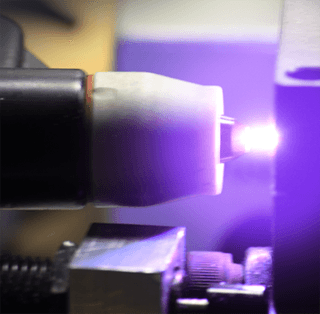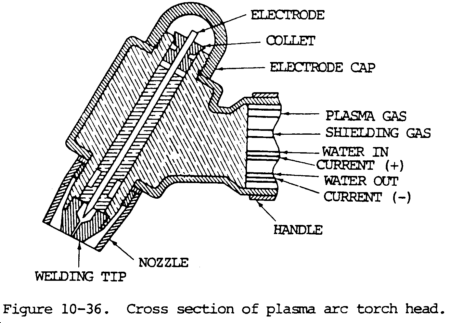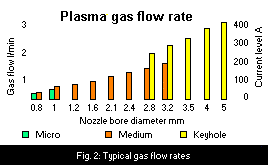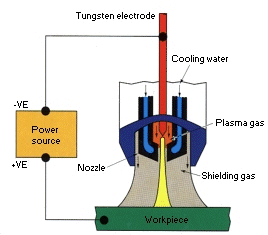Plasma Welding Equipment Information
Plasma welding machines melt areas with an arc and then use a high-velocity, high-temperature ionized gas to make welds. The process of plasma welding is used to bring better control to the arc welding process in lower current ranges. It provides an advanced level of control and accuracy in order to produce high quality welds in miniature or precision applications and to provide long electrode life for high production requirements.
Welding stainless steel. Video credit: Multiplaz Inc. / CC BY-SA 4.0
Plasma is gas, such as argon, which is heated to an extremely high temperature and ionized so that it becomes electrically conductive. It is commonly known as fourth state matter (after solid, liquid, and gas) and consists of free electrons, positive ions, atoms, and molecules. The high-velocity ionized gas conducts electricity from the torch of the plasma welder, heats the workpiece, and then melts the material. Plasma welding is similar to Tungsten gas (TIG) welding. In both processes the arc is formed between the end of a small diameter tungsten electrode and the workpieces, but in plasma welding the electrode is positioned behind a fine bore copper nozzle in the torch. Plasma is formed by forcing the arc through the nozzle and creates a characteristic columnar jet.
The arc’s contact with the working surface creates a high-heat circuit which can melt a section less than 1/16 in. (1.6mm) wide. With some plasma welding machines, the plasma arc travels through the nozzle at a speed of up to 20,000 feet per second, and at temperatures as high as 30,000º F.
Advantages of plasma welding. Video credit: STVwedling / CC BY-SA 4.0
The many benefits of using plasma welding include the precision, ability to weld small parts, and high production capabilities. Plasma is a very precise welding process due to the stable, concentrated arc, and forgiveness in the arc length variation (+/- 15%). The ability to weld small parts is important for delicate welding applications such as medical equipment. Small part welding is possible due to the low average capabilities (as low as .1 amps), it is stable at low amps, and it has a gentle arc transfer with no frequency noise. Plasma welding has short weld times and longer electrode life which contributes to its ability to do high production welding. A high performing plasma machine can produce exceptionally high quality welds.
Plasma Welding Equipment
Complete welding systems including
Complete systems including brazing, cutting, soldering, and/or surfacing subsystems. They also include a power source or station; a torch, iron or gun; cables, feeders, and positioners; robots; and other required components.

Image credit: Medical Device Welding Services
Power sources or power stations are sometimes called welding power sources. The required output power is enough to melt the material. Plasma welding is typically operated with a DC, drooping characteristic power source. Dropping, also referred to as constant current, will deliver essentially constant current for a given power source setting. For mechanized welding, this power source is ideal because it maintains the current setting even when the arc length varies. Negative polarity minimizes the heat produced in the electrode since approximately 1/3rf of the heat generated by the arc is produced at the cathode and 2/3rds at the anode.
Gun or torch consists of a tungsten electrode or welding tip, nozzle, insulating handle, hoses and hose connectors, and electrical cable and cable connectors. The tungsten electrode in a plasma arc welding gun is located behind the copper nozzle with a small tip within the gun. This protects the electrode from shielding gases and atmospheric gases. The torch electrode and the nozzle tip initiates a pilot arc between them and the arc is then transferred to the metal to be welded. The torch is able to deliver a high concentration of heat to a small area through the small opening. A positive electrode torch is used for welding aluminum which requires the cathode to the on the material to remove the oxide film. Plasma torches are complex pieces that must be thoroughly inspected and maintained throughout its lifetime.

Plasma arc welding torch. Image credit: Weld Guru
Monitors in the machine provide some combination of data to the user associated with output current, displacement of the joint width, output voltage level, temperature of the tip or iron, output power level, as well as joint resistance level.
Controllers in the machine can be selected to control the output current and power based on input sensor data, the traverse speed, as well as the torch position.
Operating Mode
By adjusting the bore diameter of the plasma welding nozzle, three welding processes can be achieved.
Mircoplasma (.01 to 15A) - Microplasma arcs are operated at very low welding currents. The process is used for welding thin sheets, and wire and mesh sections since the needle-like stiff arc minimizes arc wander and distortion.
Video credit: Kojimasayu / CC BY-SA 4.0
Medium current (15A to 200A) - Medium current plasma welding has a stiffer arc because the plasma is constricted. This technique has deeper penetration and greater tolerance to surface contamination including coating. The machines used for medium current welding must be highly maintained to ensure consistent performance of the torch.

Image credit: TWI
Keyhole plasma (over 100A) - A very power plasma beam is created when the welding current and plasma gas flow are increased. This plasma beam can achieve full penetration in a material. During welding, the hole progressively cuts through the metal. A molten weld pool flows behind and forms a weld bead used to weld thicker material in a single pass. Keyhole plasma provides deep penetration and high welding speeds for materials up to 6mm for a single pass. A two-pass technique can be used for thicker materials. Keyhole plasma welding is only suitable for mechanized welding.
Video credit: Melttools / CC BY-SA 4.0
Input Specifications
AC voltage and frequency- AC is difficult to stabilize to it is not generally used in the plasma process. If an AC power source is going to be used a square wave AC (inverter, switched DC) makes the AC plasma process easier when combined with an efficiently cooled torch.
Input current- Input current is the rated current required for proper operation of the machine.
Phase:
- Single-phase- Single- phase is the standard for commercial and residential applications. The term means one sinusoidal or other alternating-voltage pattern.
-
Three-phase- Three-phase power contains three simultaneous, sinusoidal or other alternating-voltage patterns, typically 120° out of phase with each other. High power efficiency and smoothness of operation are possible with three-phase operation. Three-phase power is used most often for industrial or high-power motors.
Number of channels is the number of sensors, inputs, or channels that the machine can monitor.
Output Specifications
Output power capabilities include several options which must be considered when selecting a plasma welding machine.
- AC output has the current output vary over time sinusoidally with an alternating current (AC) supply.
- DC output remains a constant value over time with a direct current (DC) power supply.
- AC/DC selectable can provide an AC or DC as needed.
- High frequency power supplies are used for induction welding and arc welding of aluminum or other alloys with a tenacious oxide skin. High frequency is useful in initiating an arc.
- Pulsing or sequencing of current, polarity, or arc duration can reduce spatter and improve weld quality.
- Wave shaping is a feature in the machine. The machine has the ability to shape the output power wave form, which can be an advantage when welding certain aerospace alloys.
- Square waves show abrupt changes in power supply from crest to peak.
- Constant current (CC) is maintained by the machine and consists of a steady output current level.
- Constant voltage (CV) is maintained by the machine and consists of a steady output voltage level.
Output current range is the designed current range of the welding unit.
Output voltage range is the designed voltage range of the welding unit or the voltage range monitored or controlled.
Peak output power refers to the peak electrical power provided by the machine.
Features
Automated welding consists of machines operated via CNC or robotics. Automatic welding is defined by having all the welding parameters are controlled and manual adjustments cannot be made during welding. Robotic welding uses a robot that can be pre-programmed to different welding paths and fabrication geometries. Automated systems can increase productivity, provide consistent weld quality and rates, and lower part costs. They require a higher initial capital investment and higher production requirements to justify the costs.
Engine driven generator refers to gasoline, diesel, or other fuel-powered motor-generator welding power sources.
Corrosion resistant machines can be used in marine applications such as shipyards, paper mills, chemical plants, underwater welding, and offshore drilling platforms.
Programmable machines allow for recall settings and for the operator to program specific sets of sequences of parameters.
Remote control machines can be controlled remotely with a pendant, foot pedal, and other remote control units. This allows for the operator to have an additional hand free for holding or positioning.
Water cooled machines use a supply of water to maintain the welding, cutting gun, or other unit component at a lower temperature in order to improve the duty-cycle and reduce component over-heating or erosion.

Image credit: TWI
Applications
Plasma welding machines are used in many applications. They provide high-quality welds and fast travel speeds. Some plasma welding machines are used in metal working, switch gear construction, and part fabrication applications. Others are used in the manufacture of heating, ventilation and air conditioning (HVAC) systems. Plasma welding can be used for high volume welding of strip metal, to precision welding of surgical instruments, and automatic repair of jet engine blades.
Plasma welding machines should adhere to American National Standards Institute (ANSI) standards.
